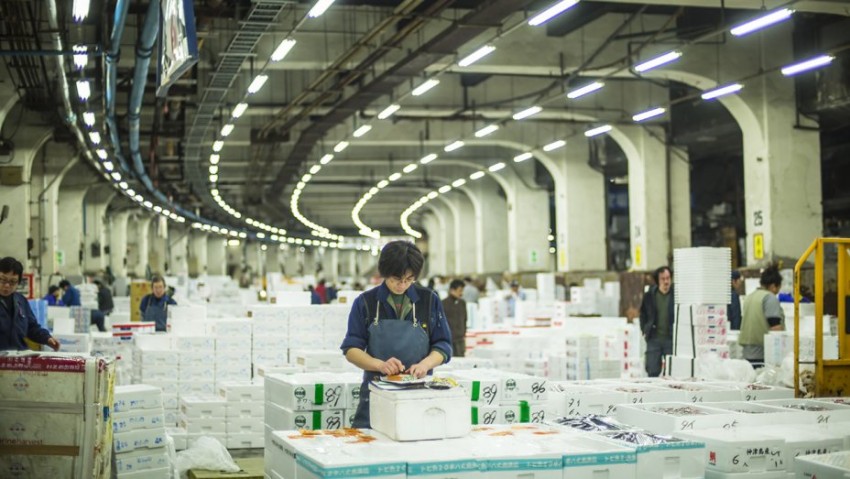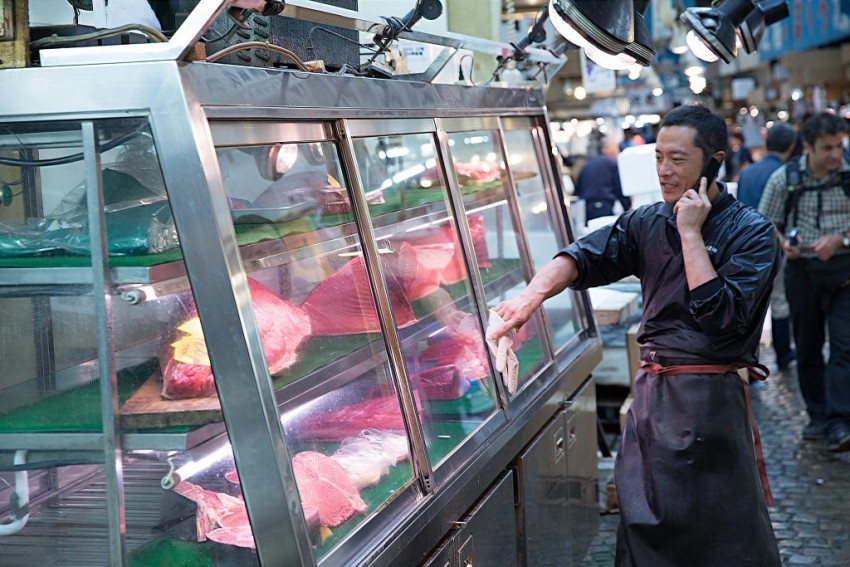Tsukiji Wonderland
February 12, 2017 · 0 comments
By Jasper Sharp.
 It was only last year that the Japan Foundation UK began including documentaries in its annual touring film season, with Aya Hanabusa’s intimate depiction of a family of butchers descended from the stigmatised buraku class, Tale of a Butcher Shop (2013), the first to be included in the line-up. This year, we move onto seafood, with Naotaro Endo’s Tsukiji Wonderland (2016), an account of a year in the life of the world’s largest and most famous fish market. It is, nevertheless, a very different proposition, matching its subject matter in terms of scale and sprawl.
It was only last year that the Japan Foundation UK began including documentaries in its annual touring film season, with Aya Hanabusa’s intimate depiction of a family of butchers descended from the stigmatised buraku class, Tale of a Butcher Shop (2013), the first to be included in the line-up. This year, we move onto seafood, with Naotaro Endo’s Tsukiji Wonderland (2016), an account of a year in the life of the world’s largest and most famous fish market. It is, nevertheless, a very different proposition, matching its subject matter in terms of scale and sprawl.
Asian documentaries in general get short shrift in UK cinemas, although English-language documentaries about Japan or Japanese subjects are not so rare. Louie Psihoyos’s contentious The Cove (2009) and David Gelb’s altogether more cheery Jiro Dreams of Sushi (2013) are two such American-produced offerings that deal with very different sides of the country’s relationship to the marine world. Tsukiji Wonderland is a more natural successor to the latter in its celebratory portrait of the people and processes behind-the-scenes in the journey between sea and stomach. Its English-language introductory voice-over, the glossy cinematography (replete with cherry blossoms and nocturnal time-lapses of trucks and forklifts, not to mention the presences of a French chef and a Harvard anthropologist), indicate that its makers clearly have an international audience in their sights.
 There’s no doubt that Tsukiji itself is a unique space. Its size alone is quite staggering: an aerial shot reveals how it takes up an entire block of the capital. The market was developed after Tokyo was levelled by the Great Kanto Earthquake of 1923. When the lengthy construction process reached completion in 1935, it boasted some of the most modern architecture in the world. The film does a wonderful job of capturing the hive of activity within its cavernous interiors, the teeming throngs of those involved in cleaning, packing, freezing and auctioning the whole piscine panoply of abalones to urchins, cockles to congers and sardines to swordfish.
There’s no doubt that Tsukiji itself is a unique space. Its size alone is quite staggering: an aerial shot reveals how it takes up an entire block of the capital. The market was developed after Tokyo was levelled by the Great Kanto Earthquake of 1923. When the lengthy construction process reached completion in 1935, it boasted some of the most modern architecture in the world. The film does a wonderful job of capturing the hive of activity within its cavernous interiors, the teeming throngs of those involved in cleaning, packing, freezing and auctioning the whole piscine panoply of abalones to urchins, cockles to congers and sardines to swordfish.
As the Harvard professor Theodore C. Bestor notes, Tsukiji is very much a social environment in which all communication takes place face-to-face. With its system of business based on personal relationships, on individual specialist knowledge of the various products, and on the verbal information that accompanies their exchange, it is very different from other global commodities markets, where mass transactions of goods such as sugar and coffee are traded wholesale at the press of a button. Everything is surprisingly low-tech here, the walls adorned with whiteboards containing hand-written messages, the building’s offices crammed with paper files.
Bestor’s sequences are the most interesting in the film. His outsider’s perspective and scholarly detachment is leavened by the genuine sense of bonhomie he appears to share with the various salt-of-the-earth types working there, with whom he became acquainted during the 15 years researching and writing his book Tsukiji: The Fish Market at the Center of the World (2004). His voice is, unfortunately, all but drowned out by the tide of wholesalers, restaurateurs and food critics all keen to point out that the best seafood in the world is to be found at Tsukiji, with the film teetering into food-porn territory as such aspects as the freshness and seasonality of the product are emphasised by a relentless tsunami of sushi chefs. “It’s like eating the four seasons that they lived” gushes one cuisinier over a lovingly presented bowl of sardines over rice, before things conclude with an extended sequence espousing the virtues of fish for kids’ health over a modern diet of burgers and ramen.
There is little in the way of structure or rhythm to the way in which information is presented, with the same points reiterated over and over again, as if the film’s makers were afraid of discarding any of the footage they’d shot. This relentless 110-minute trawl does occasionally dredge up some goodies, such as the eel dealer who draws our attention to the fact that each of the dozens of specimens that writhe through his hands every day have individual faces, scenes of a dedicated ‘detoxification centre’ full of tanks of the infamous fugu blowfish, warehouses crammed with icy rows of frozen bluefin carcasses, and the swarms of cats that emerge in the evenings to lap up the remnants of another day’s trading. There’s also some wonderful rare archive footage of the market’s construction and the crowds flocking through its vast spaces during the inauguration ceremony.
 The declaration by one wholesaler, that “Guys who work at Tsukiji, they live in a fish fantasy”, pretty much sums up the whole exercise. There’s much emphasis on timeless traditions and the Japanese work ethic, but the film itself largely exists in its own apolitical, ahistorical and acritical bubble. Although a vendor points to the massive drop of fishmongers in Tokyo compared with only a few decades earlier, and one chef introduces the idea that climate change is influencing the fat content of certain species, there are certainly some environmentally pertinent questions to be posed about the drain on our oceans, such as what has been the impact of Fukushima on the hauls from Japan’s local shores?
The declaration by one wholesaler, that “Guys who work at Tsukiji, they live in a fish fantasy”, pretty much sums up the whole exercise. There’s much emphasis on timeless traditions and the Japanese work ethic, but the film itself largely exists in its own apolitical, ahistorical and acritical bubble. Although a vendor points to the massive drop of fishmongers in Tokyo compared with only a few decades earlier, and one chef introduces the idea that climate change is influencing the fat content of certain species, there are certainly some environmentally pertinent questions to be posed about the drain on our oceans, such as what has been the impact of Fukushima on the hauls from Japan’s local shores?
The most glaring omission is any mention of Tsukiji’s own uncertain future, following the former Governor of Tokyo Shintaro Ishihara’s calls for it to be relocated as part of the great pre-2020 Olympic gentrification of the capital. The surrounding area has already proven a magnet for property developers, and while the long-threatened closure of the market scheduled for 7th November 2016 has been postponed, there’s no doubt that the days of its current site are numbered.
The image presented by Endo’s film is of a Tsukiji frozen in time – what it is at the present, what it has been for the past 80 years, and how it would like to be remembered. But the overall self-congratulatory air never really gets to the nub of what it is that makes Tsukiji so fascinating for foreigners and why it has proven such an enduring landmark on the Tokyo tourist trail over the years. If there’s an international audience in mind here, it is probably one trying to pass time while stuck on a long-haul JAL flight, but there’s little here that hasn’t been served up in more digestible form by the likes of Rick Stein.
Tsukiji Wonderland is one of the films appearing in the Japan Foundation’s UK film tour.
Leave a Reply